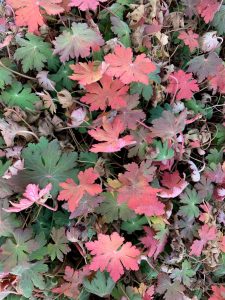Authored by: Carol Shirk
 Hardy geraniums are a great choice for a ground cover plant in sun to part-shade locations. Perennial hardy geraniums are the “true geranium” with about 300 species available, including one native to Wisconsin woodlands (Geranium maculatum). These vary from the “annual geraniums” (genus Pelargonium), often purchased from local nurseries and grown in containers for the summer season. With a myriad of choices, there is a hardy geranium suited to every landscape, although they are vastly underused.
Hardy geraniums are a great choice for a ground cover plant in sun to part-shade locations. Perennial hardy geraniums are the “true geranium” with about 300 species available, including one native to Wisconsin woodlands (Geranium maculatum). These vary from the “annual geraniums” (genus Pelargonium), often purchased from local nurseries and grown in containers for the summer season. With a myriad of choices, there is a hardy geranium suited to every landscape, although they are vastly underused.
Hardy geraniums go by several colloquial names, but the most common is cranesbill geranium because the long, slender fruit strongly resembles the beak of a crane. They can also be referred to as wood or wild geraniums because of their native habitat, blood red geraniums because of their fall foliage color, or bigroot geranium because of the obvious thick root of some varieties.
Hardy geraniums are nearly effortless to grow. They vary from 6–24 inches in height, like medium, well-drained soil and sun to part-shade locations, blossoming better with a bit more sun. Plant them with the crown at or slightly above soil level. Once established, they require very little attention and are fairly drought tolerant. In fact, too much water may lead to crown rot, fungal disease, or slugs. Therefore, only provide supplemental water if it is exceptionally dry or when first establishing the plants.
These plants have no serious pests, are deer and rabbit tolerant, and require very little maintenance. Deadheading is unnecessary. The foliage can be lightly sheared back to reshape the plant, but this is also unnecessary. In early spring, simply remove any winter damaged or dead growth and allow the plant to continue the growth cycle. The plant will spread over time and clumps will need to be divided every three to five years or when it outgrows the allotted space.
Most bloom from mid-spring to mid-summer. The blooms of pink, white, blue, lavender, magenta, violet, purple, and all shades in between attract a wide variety of pollinators: different types of bees, including native bees, syrphid flies, beetles, and ants. Foliage ranges from shades of gray and green with some turning to a flaming orange and crimson in the fall.
The native species, Geranium maculatum, has large pale pink to lavender flowers. They have a month-long late spring to early summer bloom time. This plant grows in deciduous forests, but can easily be cultivated as a perennial in your home landscape. Start from seed, purchased or gathered in the wild, or from division of the rhizomes and use in a border, native, or woodland garden.
If you choose to go with a cultivated variety, the choices are endless and almost overwhelming. However, the Chicago Botanical Garden conducted a 15-year study of 180 different varieties. They considered ornamental qualities, ease of growth, hardiness, as well as disease and pest resistance. You can access the results here: https://www.chicagobotanic.org/sites/default/files/pdf/plantinfo/geraniumfinegardening2012.pdf
These tests were run in the same 5b growing zone as southeast Wisconsin and mimic the minimal care that homeowners would give. Therefore, this record would be a very accurate picture of how these plants would perform in Dodge County landscapes. The hardest part is going to be choosing only one. But, dive in and pick one to try. I am quite confident you will not regret adding this garden-worthy hardy perennial to your landscape.
Carol Shirk
Certified Master Gardener




